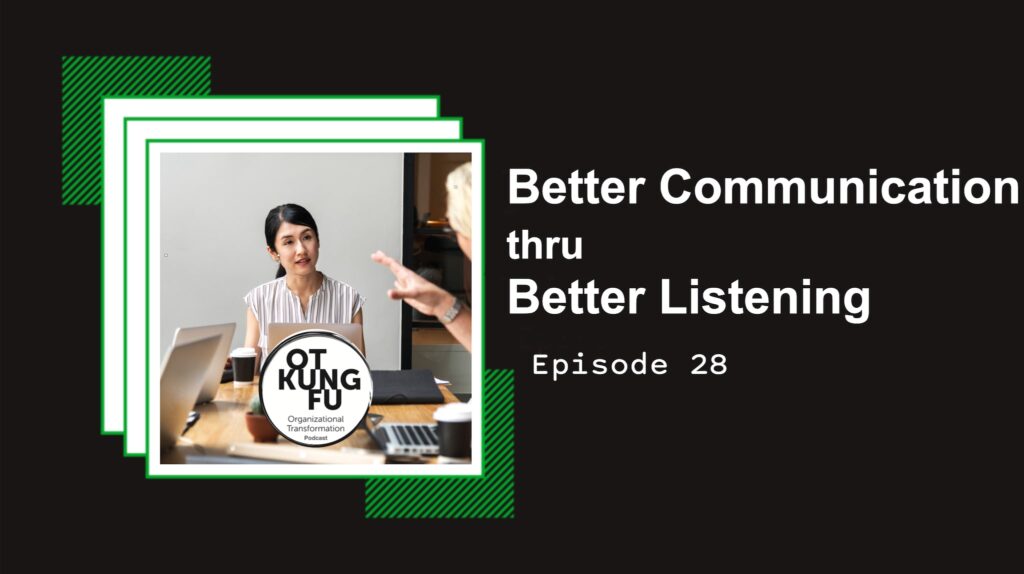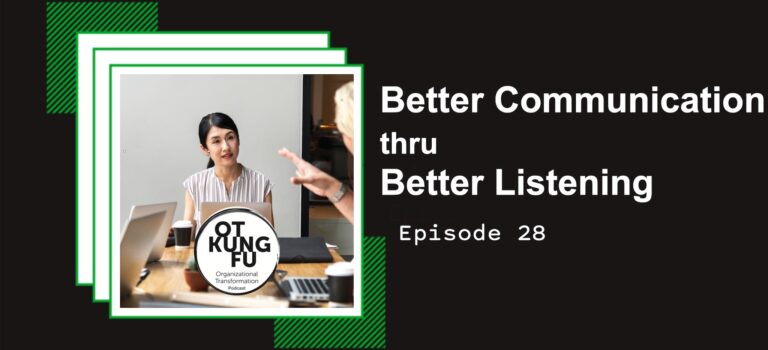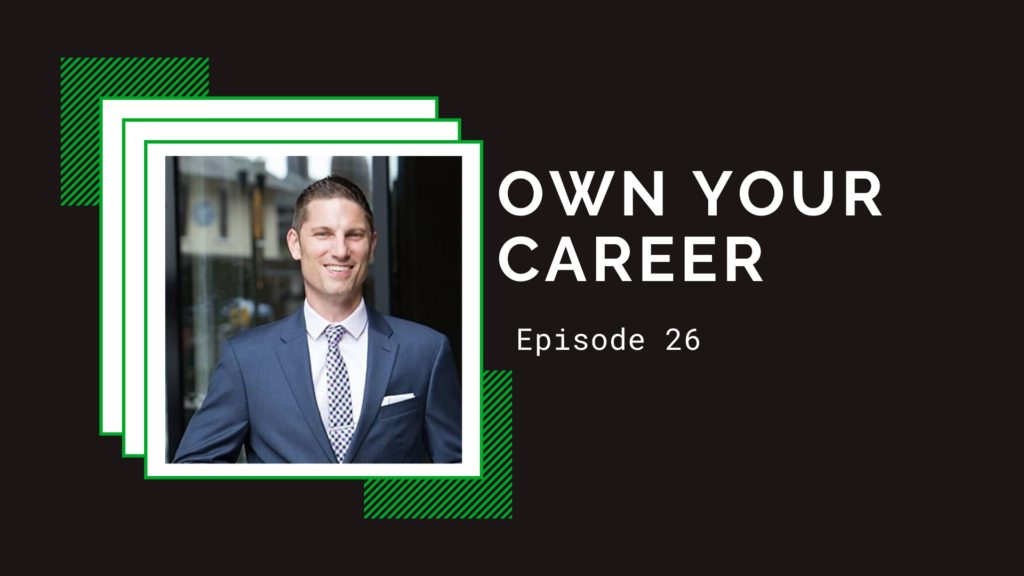
Sandi and Jen talk about listening being the key to communication and that good listening is a big part of being an effective leader. They also go over active and advanced listening as well as ‘listening in judgement’ vs ‘listening in discovery’.
Leadership Kung Fu


Sandi and Jen talk about listening being the key to communication and that good listening is a big part of being an effective leader. They also go over active and advanced listening as well as ‘listening in judgement’ vs ‘listening in discovery’.


Sandi and Jen discuss what Vision is for business. They talk about Vision vs Mission statement. They also go over how story works with Vision to keep it front of mind for everyone, how to create a business vision and they touch on how personal vision will help engagement.


Sandi and Jen have a discussion with Andy Storch, author of Own your Career Own your Life. They talk about what it means to Own you Career in a company setting and what are the issues that go with those decisions.
Vist Andy’s website here: https://andystorch.com


Sandi and Jen discuss what is a self-directed team, what are the items and issues that come up for a good and for a bad self directed team.

In Fall of 2018, Gary Anderson was hired to be the CEO of Nova Mutual Insurance in Ontario. This was a new position as Nova Mutual was a newly merged organization.
Now two and a half years post merger, Gary in his first C-suite role is clearly writing his own playbook. Gary and his team at Nova Mutual are doing things a little different, and they believe that culture will drive results, so although the results matter, culture trumps results.
Gary is not the typical CEO, and in fact carries the title of Chief Empowerment Officer.
But is that just a cute play on words, or are there significant differences in the role he plays in the office? At Nova Mutual, one of their chosen core values is empowerment, and according to Gary, the title change seemed to fit the mold. At Nova they pride themselves in doing things differently so much so that even now Gary is considering the next evolution of his role.
There are several pieces to the puzzle of culture and transitioning from a traditional office to an office driven by culture, and Gary believes it starts with servant leadership.
A servant leader could be well-compared to the scrum master. If you haven’t heard of this term before, a scrum master is an individual that facilitates good discussions, but isn’t the expert. Their primary goal is to listen and remove obstacles that are hindering the real experts from creating the best team or outcome possible.
If a traditional office structure is a hierarchy like a triangle, servant leadership means turning that triangle bottom up. As a servant leader, you’re removing obstacles, allowing the superstars to do their thing, and in turn they’re going to make things more efficient because they’re making the decisions about their job and how to streamline it.
Instead of having one leader at the top, with all of the pressure and control, there are many minds figuring out the details of how to get done what needs to be done in the best way possible. By removing the top down approach you start getting all sorts of ideas that no single ‘top-dog’ would ever have the time, freedom, or energy to think of.
When you have this kind of participation, it paves the way for buy-in, rather than begrudging (or worse, apathetic) compliance.
We know some of you might be wondering if this change is even worth the effort. If it’s not broke, don’t fix it, right? However, there are a few clear issues that come with traditional top-down leadership, and there’s one in particular that is impossible to avoid and that is poor communication. Top-down leadership means there’s someone at the top with typically three people as next-level leaders, who in turn relay information to 10 other employees, and continuing down the line.
Usually, this process of communication doesn’t go well, because somewhere within the middle management, details start to get lost, twisted, or added to.
Like a classic round of the popular party game Telephone, the message totally changes by the time you’re done. That’s exactly what traditional top-down management communication does.
When transitioning to a completely different leadership strategy and structure, you have to start by gathering information about the existing culture. By using preliminary surveys, you can reveal a lot of information, mostly from the comment sections. The typical click type answers can lead you down a general path, but it’s the comments that are key.
You’ll find, as you get to know the existing culture and individuals, there is a wide difference in beliefs, priorities, talents, and expectations. Somehow, you have to convince this group of diverse people to buy into a new culture and a new identity. But before that, you’ve got to decide what you want that culture to be.
Culture will happen regardless of what you do. It’s constant. You can either be completely invested in constructing or influencing it, or you can do nothing and it will create itself.
Gary used the first year as the transition year, and his goal was simply to bring everyone together. Not transforming anything, or making big moves, just getting everyone accustomed to these new concepts.
One step in this transition is getting your team involved by participating in conversations about purpose and values. It takes time, but it’s vital to create a safe space to have these conversations, because during transition periods, your team members are all asking themselves the same questions:
Where do I stand?
Am I staying, or am I going?
They may find out they’re not a fit. Maybe there’s not a career opportunity for them with the direction you’re going. You want the culture to be a genuine place for conversation and empowerment, so if one of your employees discovers something new they want to do, they will be supported. If they can do that within their current position in the team, great, let’s do it! If they can do it in a different position on the team, also great. If they can’t fulfill that goal with your team, they’re going to have the support they need to find a new job that gives them what they need to grow.
The change is gradual. Some team members might have never been put into a work situation where they could speak freely. Some team members might not believe you mean what you say. Everybody’s watching to see what moves are actually going to stick, and it comes down to trust. You have to build up the trust in advance, before you start making claims or taking chances.
This transition period, where you’re focusing on communication with regular, inclusive conversations is not just for building rapport and practicing for the “real thing.” As the leader listens and the team talks, culture is co-created. You’ll notice patterns in how the team communicates, what they talk about, and why.
Rather than simplifying it as a traditional mission and vision statement that you see on everyone’s website, Nova Mutual chose to alter it.
They started by answering the question, ‘What is our purpose?” and “Why do we exist?”
Then, they boiled it down to core values. These are catchy buzzwords, and they can sometimes be put on a plaque and ignored, but it’s getting the team members involved in the discussion. Instead of a CEO saying, “We’re going to believe in these three things, and if you don’t like it, hit the road” that’s what this process is all about.
Nova Mutual came up with six values, but Gary made it clear that they could change at any time as the team changes. Here are the words the Nova team chose:
This, they decided, was their true culture.
Ultimately, the servant leadership strategy leads in one direction. However, ater the transition phase, the goal (at least, for Gary at Nova Mutual) was to also create self-managing teams.
Many people think the idea is madness, and wonder how anything gets done, but really it’s just the natural extension of culture-driven strategy.
At first, you keep it simple with functional management. When the team has a discussion about potential changes, the servant leader (traditionally the “functional manager”), gives options of how these changes could be implemented. Then, they give them a small structure to work with, using examples from what they’ve been doing as a larger team up to this point. For example, meeting together every day, talking about stuff, taking 10 minutes to clarify who is doing what, and being intentional about problem solving within the group.
If self managing teams are going to be high-functioning teams they have to want it. They have to be ready to give 100 percent, especially at the start. As you build trust, the goal is to be able to rely on anyone on your team at any given time.
Even with loads of experience in the field, this sort of experimentation requires agility. You have to be more infinite minded. The leader will have to identify certain things for the team to achieve that are aspirational. Agile, self-managing teams figure it out together and are highly efficient and collaborative.Creating a culture of servant leadership simply lays the groundwork for the magic to happen.
For more resources from the combined genius of Sandi and Jennifer, check out Management Possible and Satori Consulting Inc.
Jen is the owner of Management Possible® focused on training and coaching multi-level management and leadership individuals and teams nationally and globally. Sandi is the owner of Satori® Consulting inc. a global consulting firm focused on helping organizations solve complex problems in strategy, leadership and governance.

Companies are looking for managers to get better at developing people, not just managing them. This shift is geared toward improving feedback to be more consistent and frequent between employees from managers.
It’s fair to say that most people do come to work and they want to do a good job. So how do we keep ramping that up? By coaching your employees, however, most companies need some guidance to wrap their heads around the idea of coaching culture. This concept has been on the uptick over the last several years.
Coaching culture has garnered this reputation for impacting performance. It’s the next big strategy. More and more organizations are investing in coaching skills for managers. Over the last five years or more, companies have paid a lot of money to train managers how to coach, but they’re still struggling to achieve change in how managers actually engage in coaching.
The problem for most organizations is twofold.
First, results always come first and hold the most sway when managers are evaluated on their performance. Did the team deliver on that expectation? Did they reach the target dollar amount in revenue or cost savings? Did they implement quickly and on target? Did they reach their goals? The qualitative data always trumps development efforts.
Second, managers are rarely held accountable for coaching their employees. They talk a lot about it, and they use the word coaching, but there’s little accountability actually engaging in it. So there’s no doubt that managers are either having difficulty understanding the difference between coaching and managing or are simply choosing not to do it consistently or with any frequency..
The bottom line – there’s increased conversation about coaching, but the conversations aren’t making that big of a difference.
There have been a few studies that analyze the effectiveness of coaching skills for managers and overall the results aren’t great.
Organizations think it will be tremendously different when they start implementing a coaching culture. They’ve seen it work with external coaches. It’s a proven method and by providing the tools to managers they rightfully think they’ll get amazing results, but it’s proving to be somewhat disappointing when you look at the results of their actual internal coaching effort and the underwhelming return on investment.
Part of it is a semantics issue, which is impacting the expectations and the results that they want. For the most part, people see ‘“coaching” as feedback skills, and those terms have started to be used interchangeably.They might be getting better at feedback, but it really doesn’t translate into performance development or significant improvement. Employees might be getting better information about what they’re doing or not doing, but that doesn’t mean they agree with what they’re being told, or that they’ve been given any support or direction to improve on it.
Coaching and feedback are not the same things. For example, a lot of large companies have invested in the GROW model training for managers:
Goal
Reality
Options
Will
It’s meant to simplify the coaching into a conversation that targets the goal, change, or improvement against the reality. What are you doing, and what can be implemented or changed? What are the options? What are the steps for the actual change? Do you, and your team, have the willpower it takes?
There are certain things about this process that initiate a huge conversation. Some managers are intimidated by what that model is asking them to do. It feels messy and time-consuming, and maybe it’s more information than they’re interested in knowing or spending time on. Especially when the pressure organizationally is more about the results not the development–the “what” not the “how.”
The important question is, who owns the coaching culture? Is it the coachee? Is it the manager who owns the coaching? Responsibility is important because this process can feel overwhelming. If you have multiple employees, it could be exceptionally daunting. There’s all this other work that needs to get done, and the temptation to return to managing is real. It’s easier to tell somebody to do something, rather than having a conversation that will motivate them and potentially change their perception of the work they’re doing.
They’ve got to be willing participants. That’s the first role of coaching when you come in from the outside. You can’t start with somebody that is disengaged, because chances are the coaching is too little too late. If you’re looking for managers to engage development, they need a mindset and a belief in the value of it first. You’ve got to have willing participants. They’ve got to be willing to take the time and see it as a l priority.
One of the issues is that people always want to do it internally. Of course, if possible, you absolutely should. However, especially in big companies, confidentiality and the sharing of information of coaching engagements must be addressed.
With an external coach there’s a release valve there for people to be able to speak their mind, to really get to some of the things that need to be dealt with. Whereas when you’re trying to do that internally, confidentiality can create an issue. For example, if somebody you’re working with says something that could potentially be an HR issue, what then is your obligation to say something to HR? It can get pretty mucky, internally. But the whole idea of the coaching is to have an open dialogue.
To be able to have open dialogue for topics of a more difficult level, managers need to break through the uncomfortable, unfamiliar level first. Usually, after a company has used an external coach, they’ll want to find out what they can do on their own. If you’ve had good external coaches that have made an impact on the business, it’s a natural progression to want to run it internally.
Employees want more engagement relative to their skill development, as opposed to just being sent for training. Similarly, leadership doesn’t want another no-impact program to add to the budget. However, they’ll buy-in to coaching efforts as an investment in their management development. Why? Because coaching is personalized and very targeted to specific roles and circumstances, which training programs don’t always provide.
If as a manager you start getting good as an internal coach, it creates a supportive, disciplined environment. It makes it easier when you get frustrated, stuck, or stymied. You’ve got an internal structure to pull a coach in when there’s a problem with a team.
When we compare coaching to managing, managing is really about the work, tasks, and projects. It’s about setting the expectations, modifying the expectations, giving feedback about how you’re doing against those expectations. Putting that into a basketball metaphor, managing is more like the scoreboard and the referee. How are we doing? What’s the score? Are we fouling out? Are we playing by the rules?
Coaching, on the other hand, is the conversation that takes place during the timeout to evaluate the situations and strategize the improvements to get better results in the moment.
When you call that time-out, in less than a minute, everyone agrees and makes the appropriate changes. Coaching culture is disciplined ownership of the input provided. It’s the feedback, but it’s also the acknowledgment and the initiative of the player to take on the subsequent actions and engage the change.
A lot of businesses can do the feedback, but it’s the discipline of engaging the change that generally misses the mark. Feedback is paramount to that coaching relationship: being able to listen, engage, and provide notes for people’s personal development.
To get ownership of the coaching, you have to understand the “why” of their organization’s desire to move into a coaching culture. Why is your organization doing it? Are they doing it because it’s the flavor of the week? Are they doing it because they want to really shift the organization and move the level of their management staff in terms of their conversational skills? You have to be fully engaged in the internal processes.
If you employ accountability for coaching, you’re probably not employing accountability for managing. If you’re going to shift to a coaching culture, the only way you’re going to get there is to deal with your accountability problems first, because that discipline and accountability is as much a coaching skill as anything else. Usually, that’s why you pay a coach from the outside to come in as they are more likely to hold the proverbial feet to the fire.
Part of the coaching experience is knowing the rest of the tools in addition to coaching. Learning the communication styles, team behaviors, emotional intelligence, and how to empower others to own their work.
There are so many pieces that have to be in place to actually make it work, and make it work well. Organizations that get it are able to step back and plan for the transformational shift. It’s not a one-and-done thing. There has to be process and rigor behind it. What is the benefit to your organization to go down this path? When you’re clear on why you’re doing something, it’s easier to put the pieces in place.
For more on coaching culture, check out the OT Kung Fu Podcast.
Jen is the owner of Management Possible® focused on training and coaching multi-level management and leadership individuals and teams nationally and globally. Sandi is the owner of Satori® Consulting inc. a global consulting firm focused on helping organizations solve complex problems in strategy, leadership and governance.


Sandi and Jen discuss what Empathy is and what Leading with Empathy is all about. They discuss empathy, sympathy, judgement and curiosity and how they are all related and how these affect leadership.

How do we hold people accountable?
This is the overarching question that most organizations struggle with. A lack of workplace accountability is typically the result of tolerated behaviors that become an organization’s culture.
On the podcast, we’ve been talking about strategic planning, nailing your positioning, and effectively communicating with your team. Accountability is the next step because once you’ve done the planning, it’s all about putting that plan into action.
Most executives are fairly good at the action part: driving the results with the organization is what they’ve been trained to do their entire career. However, it’s important to consider the quality of those results because that’s where there’s room for improvement.
A couple of really big indicators in an organization suffering from workplace accountability issues are low employee engagement, poor performance results, and turnover in top talent. There’s an overall dissatisfaction, either about the work, or the work environment, or both. That doesn’t mean it’s everyone, and it doesn’t mean that it’s all the time, but it’s a significant number of people to impact the business negatively.
It’s used as a giant catch-all word. So let’s identify what we really want.
If you can’t do accountability, you can’t manage, let alone lead. Workplace accountability is often used in the corporate environment to describe whatever is missing, or what’s needed. You might hear:
“If we had more accountability from the IT team, this project would be further along.”
Everybody points to accountability. Everyone usually agrees with these statements, but they don’t take time to understand what that means or come up with a meaningful and consistent plan to address it as well as sustain it.
Unfortunately, what is usually behind the request or demand for accountability is results, fast. It’s often used as a threat. When used this way, accountability becomes the stick to punish, as opposed to a useful tool to guide and protect everyone on the team. Holding someone accountable is not a punishment. Accountability is not punitive.
Accountability is an act of clarity. It’s only outcome is clarity around ownership of either actions or inactions and the associated choices behind those actions or inactions. This is why we want accountability; we want the clarity of ownership of responsibility.
However this also means we have a firm grip on idea and use of consequences because they’re inextricably linked. Without them, there is no workplace accountability.
What does employee engagement have to say about accountability?
Here’s an example:
On your team, there’s one employee who consistently shows up without getting the work done that they commit to between meetings. So the rest of the team pitches in to get things done. After some frantic make-up work, the job is completed and everybody can move forward. Maybe the first time it’s okay and everybody’s happy because it’s done. But, if it happens time and time again, the team starts to get disappointed, probably annoyed. Still, the team might not make any changes, and they continue to move through it.
Then, the third, fourth, and fifth time it happens, no one ever says anything and that person gets used to their new role and a new set of (much lower) expectations. They’re not being held accountable. There are no crucial conversations going on and everybody else has to shore up.
The longer it goes on, the more disengaged and disgruntled the other team members become. At this point, the water-cooler talk starts to happen, but nobody’s going to talk to them directly. This is now escalating from what was just a solvable problem into a team conflict. What could’ve been treated and prevented by a single crucial conversation has probably evolved into a situation that requires added conflict resolution.
The other indicator is poor performance results. We know that performance numbers happen over time (it’s a cumulative variety of performance pieces) but without workplace accountability along the way, the results aren’t great. They’re not going to change or grow.
People are engaged when they have a clear line of sight to what they’re doing and how that affects the strategy. When there’s no link there for them to see that, and to be aware of what they’re accountable for, no accountability will equal. No positive results.
Unfortunately, this is the kind of behavior (avoidance, or work arounds) that happens all the time. Lack of accountability is in every business, in every country, we’ve all experienced it somewhere.
Why is it seemingly effortless for some people and incredibly difficult for others?
First and foremost, many managers are promoted to leadership roles because they’re really good at their job. In other words, they are functionally great, but being good at finance doesn’t necessarily mean you’re a good leader. Holding people accountable is both a management and a leadership skill, and organizations need to get better at skill-shaping their leaders so they can execute these skills brilliantly. Sometimes, managers are better at accountability than company leaders. Leaders can get mired in organizational politics and “play nice” instead of holding a clear expectation.
Another reason accountability can be difficult is people want to be liked and with that comes the fear of breaking relationships or good dynamics. It can really feel awkward to hold people accountable unless you have the skills in your toolbox to do it well. We used the term crucial conversation before, but without the know-how to start these pivotal, performance-changing conversations (intentional, direct conversations that address a current problem while also preventing future issues), or how to make them constructive and meaningful, communication efforts won’t go anywhere. You feel like you’re having the same conversations over and over again.
Unfortunately, this desire to be liked and the resulting tendency to avoid problems, creates greater tension ultimately increasing the inevitability of conflict. Conflict is much more time intensive and difficult than accountability. Yet, so many of us continue to let what starts as a performance problem, morph into a hot mess of a conflict.
Finally, the last reason we’ll cover here is that accountability can be set as a low priority, and in an organization, limited time and energy is the last nail in the coffin. Having tough conversations initially takes time. It takes time to prepare, to schedule, to talk, and to follow-up, among other things. But that’s true only until you’ve mastered the skills. It requires dedication to the process, creativity and flexibility, and more than anything else, time. However, time spent is ultimately time saved as accountability conversations will give you your time back over time as you get better and more consistent at doing it.
It’s easy to make assumptions. When we start putting expectations out there, we assume that someone already knows something that maybe they don’t actually know. Maybe we think that they already know how to do the job, or we’re sure we talked to them about a project, or we thought they were previously trained because we sent them on a one-day training session six months ago. Assuming employees have clear expectations often leads us to the need and the essence of workplace accountability.
Accountability is both a personal value and a professional skill. In other words, accountability is a skillset and a mindset. It’s just as much a philosophical approach as it is an actual practice in the workplace.
When you move into that management role, there’s a value shift, and accountability is part of that.
When we talk about the primary drivers of workplace performance, there are two pieces: beliefs and values. A belief is something that we hold to be true, while a value is what we hold to be important. So when we say that accountability is a personal value, that means that you believe it’s important and consistently act on that. Until you find that it’s important, you’re not going to be able to use it effectively. A lot of the time we choose our fear over our value.
Accountability doesn’t happen in an emotionless vacuum. Accountability requires vulnerability, it asks for courage because it’s rooted in our beliefs and values. Accountability conversation are often done poorly. They can be awkward, blunt, and sometimes painful. This is why accountability in some organizations leads to discord and conflict management.
When done correctly, accountability is full-on empowering, letting everyone know where the lines are and if you’ve never really been held accountable, you may not realize the impact that has.
Accountability is a skillset and a mindset. At the highest level, accountability is three things.
First, it’s emotional risk, so people put it off, completely avoid it, and simply don’t do it well. Second, it’s a communication skill set. You must combine all of your skills.
Lastly, accountability is a practice. Take yoga, for example. Some days you’re really good and super flexible. Other days, not so much. Not every accountability conversation is going to be great, but the more you do it, the better you are.
Start with the communication skills. It’s more than just delivering useful feedback. Then actually practice these. Get a coach to help you. That can be a professional coach or a peer coach. Check your intention. If your intention is not clarity, support and change, then you’re doing it wrong.
That’s what OT, Kung Fu is all about! Better techniques practiced over time.
To get started, check out our flagship program Own Up!™. Go to our website and take the Accountability Assessment. Then download the information and schedule a time to meet with an experienced accountability skills coach.
To learn more, you can also visit Management Possible and Satori Consulting.
Jennifer Long and Sandi Verrecchia are the podcast hosts of Organizational Transformation Kung Fu. As Leadership Coaches they believe that transformation takes time, energy and practice to take root and become embedded as successful change within organizations. Much like the ancient art and practice of Kung Fu, transformation is a discipline.
Jen is the owner of Management Possible® focused on training and coaching multi-level management and leadership individuals and teams nationally and globally. Sandi is the owner of Satori® Consulting inc. a global consulting firm focused on helping organizations solve complex problems in strategy, leadership and governance.

Organizational change takes time to complete and even more time to master. It takes patience for the changes to take root. Now that teams work from home, and leaders are managing remote teams, there are new challenges causing the implementation of changes to be even more difficult. There are, however, a few things that organizations can do to make that change happen, as we’ve all become virtual team members in a very short period of time.
Trina Hoefling is an organizational development and transformational change consultant. She’s a graduate school professor, master teacher, strategic facilitator, leadership coach, and virtual team collaboration expert. She’s also the author of a book called Working Virtually, Transforming the Mobile Workplace and a contributing writer for The Handbook of High-Performance Virtual Teams.
OT KungFu was grateful to learn more from her expertise about virtual team building, managing remote teams, and everything a leader should know about teamwork from home.
Is there a difference between these terms?
There are certain terms you can use interchangeably: virtual worker, virtual team member, remote worker, all of those are interchangeable in day-to-day life. For our use, however, there is a difference between a virtual worker and a virtual team member.
Do those employees who work from home need to depend on each other to get the job done? Are they coworkers who are in an independent team, like in a call center environment? Or are they team members that need to work together to deliver their final product or service to their customer?
There are some things you need to know to engage the worker rather than the team member. Businesses treat every employee as a team member, whether they have to engage with others to get the work done or not because it’s collaborative.
But, the truth of the matter is, when we’re moved suddenly to a virtual environment, we have to ask ourselves two questions:
1) How much do the team members need to work together to get the job done and
2) How much is the virtual manager the conduit of the work?
A good team leader is always the most powerful piece, but when managing remote teams, they become even more important.
The virtual managers are the cream of the Oreo cookie. No matter what, they’re the primary connector of the workforce to the organization. Whether your manager is your primary contact or not, when you move to a virtual work environment, especially suddenly, that manager is your major connection with the organization, your major purpose giver, and your major contact.
It doesn’t remain that way, but at first, as people are trying to figure this out, that manager is a critical person in determining whether or not the employee can succeed. The virtual manager is the key influencer of work satisfaction and employee retention.
You take people away from their teammates, and they’re suddenly looking at their own four walls and wondering what signals they need to pay attention to and what’s most important. They need that manager to bring people together and recreate that connection to the workplace.
So what advice is there for a manager who’s just been thrust into this new virtual work environment, especially if they’ve never done it before?
How do they hold people accountable?
How do they manage results?
What do they need to do differently?
How do they know the team is really working?
First of all, the data suggests your team is working even harder because you don’t have those built-in stops and breaks. For a healthy, efficient team, the transition from team office work to teamwork from home is as simple as adding the word “virtual” to whatever you’re already doing. If you’re managing by results, now you’ll be managing by results virtually. The real question is:
How do you know they’re working now? How do you know they’re getting the job done in a normal office setting?
Do you have a result and management process in place? Do you have a performance evaluation system? Do you do coaching sessions? How do you observe behavior?
In short: What do you do now?
If you’re managing by sight alone, you’re not managing. Whatever you sucked at before your team moved into a virtual space, you’re really going to suck at it now. If you didn’t know how to really manage your team before, it’s going to be even more difficult now.
It all comes down to communication skills, and if everyone is out-of-sight, and you have no idea how to manage or communicate with others when they’re out-of-sight, then that’s where you have to start.
Pick up the phone, have a conversation, get an understanding of what’s going on, and what you’ll find is, as time goes on, fewer phone calls will be needed. But, if you’re starting from the ground up, it’s going to depend on how often and frequently you’re contacting people to really find out where things are. If the correct systems of communication aren’t already in place, you’ll have to create them. Watch for areas where the disconnects are happening that may not have shown up before.
If you feel like somebody is not doing their job, or that a coworker’s not working as much, if there’s a system in place where the leader is regularly touching base with the team, and genuinely wants to connect, those issues will take on a completely different tone.
First, good communication skills: written and oral are imperative. You don’t have to be an extrovert to be a good virtual manager. That’s a myth that we should dispel right now. You do have to care about your team members and be willing to reach out to them, but not as “big brother, big sister” oversight. What’s needed is the human-to-human connection. Authentic care about your team, communicated through the time and attention you dedicate to intentional, relational communication.
Those are the big things: interpersonal skills and caring. The other one is being clear, and helping the team be clear with each other so that you can start establishing trust in this new world. A good leader that is trusted can help a team accomplish that better and faster, rather than a leader that is hands-off and disconnected from the team.
What about the virtual worker? What are they experiencing coming into this? Panic, fear, and isolation.
Obviously, as a manager, there’s only so much you can do, but as far as work goes, some people are more comfortable using digital tools than others. Assuming that some of the team is not as comfortable, we still all have to use these tools, share information properly, and get on video conferencing once in a while.
So how do we make this part of life separate from panic, fear, and isolation?
Workers and virtual professionals can get some fun-time learning to use the tools: doing a collaborative brainstorm on a whiteboard, some light-hearted practice playing with annotations, and other forms of opportunities. Allowing them to be a learning professional who is in transition, and communicating that the expectations have shifted, will simplify things and get people’s confidence and comfort up, so they can go back to focusing on the work they’re there to do, instead of how they’re having to do it. Virtual team building doesn’t have to be completely separate from practical work or run by an external team for a one-time experience.
Teaching and training team members together as a group is also important. Let’s do some fun things, let’s make some mistakes together, share part of this transition as a team, so that we avoid the panic and isolation that might set-in if you’re forced to go through this process without sharing the experience with others.
No matter who you are, mistakes will be made. There will be miscommunications. Just plan on them, and make an agreement to assume positive intent and talk about it. The little frustrations can really collect and show up in a virtual environment. You can hide it from each other, but you’re still steaming inside.
Creativity and breaking up the day-to-day can reveal really great information on the status of your team. A mix of virtual team-building activities that range from practical to relaxing or stress-relieving is vital to managing remote teams well. Virtual happy hours, free online webinars using Zoom, letting somebody else teach the whole team together, are just a few examples.
Through these experiments, you can find the invisible threads that are connecting the individuals on your team. If that thread is M&M’s, start mailing out packets of hard boxed M&M’s to all the team members.
Be creative and fun, and realize that even in a non-crisis environment, when you are virtual, you need to make time to have some fun together, whether it’s a virtual pizza party or a virtual office tour.
But these are the extra pieces. What is the foundation of a high-performance virtual team?
The first step is simple. Develop your team.
Identifying who’s going to be on your team, helping them get to know each other, creating the right dynamic between team-members through virtual team-building opportunities, and negotiating agreements.
The second step is to support your team. This is a shared responsibility with the manager and the team members. Team care, clear flow of communication, and project scope have to be done together. Managing a remote team doesn’t mean the leader has to drown themselves in responsibility. The problem isn’t that we’re asking too much from our team members who work from home, it’s that maybe we’re not using their energy, gifts, and talents properly.
One of the most disappointing findings right now is that before the crisis, 70% of virtual team members reported they felt they were not trusted, and that they were left out of critical communications which impacted their ability to do their job.
That’s high.
We could go on and on about distance and unconscious bias, but we’ll cover it quickly.
We think like cavemen. We’re creatures of habit and we tend to trust the people we see right next to us, or at least we pay more attention to them. In our unconscious mind, we believe that somebody far away can’t be as dangerous or as helpful, because they’re not there. It’s inaccurate in today’s world, but our brain still works the same way.
This is an opportunity to get into better habits: be more intentionally inclusive, right? Nothing like a good crisis to help you grow your leadership skills!
Likewise, the team members have the responsibility to speak up and ask. It’s not all on the manager. The best way to keep each other engaged, informed, and supported is by delivering results. We all want to be part of a successful team, and if we deliver results, then we can learn to work together.
For more great resources on teamwork from home, managing remote teams, or virtual team building, check out the combined brainpower of Jennifer Long and Sandi Verrecchia on the OT KungFU podcast, or learn more about their individual work through Management Possible and Satori Consulting Inc.
Jen is the owner of Management Possible® focused on training and coaching multi-level management and leadership individuals and teams nationally and globally. Sandi is the owner of Satori® Consulting inc. a global consulting firm focused on helping organizations solve complex problems in strategy, leadership and governance.
What does going back to work look like? What is a hybrid workplace, at its core? What does all of this mean for leaders? What do we have to do differently?
These are the top questions we address in today’s episode of The OT Kung Fu Podcast.
This is the time to get rid of the policies that don’t work and the systems that are no longer serving the team. Question everything before reopening, or introducing big changes like a hybrid workplace.
There’s no going back to normal. You’re never going back to the same thing. It’s not going to be the same because no one is the same. We are all thinking differently about work. We are all feeling differently about what’s important. Just by virtue of changing as people, how we think about work, what work needs to be for us, and what’s going to create meaning for you, has shifted. Just because you’re returning to a building, doesn’t mean the job, or the environment, will be the same.
There’s a big balancing act between the short-term and the long-term when it comes to leading and decision making. What are the short-term decisions that have to be made? What are the long-term decisions that have to be made? Do they conflict? Will they be too much to handle at once? How do they relate to one another?
The changes that have occured in the last few years have been a challenge, but they have also created an opportunity for companies to rethink how they want to structure their culture. It’s an opportunity that most leaders never get: the chance to restart, a totally clean slate. The things that we previously held as gospel truth have now been proven incomplete, and companies must respond in a fearless, open-minded way.
These two come hand-in-hand when it comes to successful restructuring. Making changes, while necessary, can be incredibly difficult without support and unity, both within leadership and the team as a whole.
What is most important to your employees? What has their experience as a team member in the last couple years taught them?
How are you starting the dialogue and conducting the conversation? Are you just sitting in a room of leaders making decisions on your own? This might have been necessary as teams and companies had to simplify to survive, but for growth, you need as much information as possible.
Next, it’s time to move on from the strategies that worked when you were in crisis-mode.
For a while now, the norm has been a group of four or five people making the decision for the whole organization, without engaging with the rest of the team. While this is helpful to keep things moving in complicated times, this tendency isn’t good for the long-run.
Many leaders were so focused on pushing through, and were often so desperate to keep their organization alive, they’ve now continued to use the same strategies.
As companies are focusing on transitioning out of this phase, they are tapping into their workers, doing a lot of tiny pulsing and surveying, and are investing in their employees as people.
Before, leaders simply told them what to do, but now the principle of leading with empathy is considered a necessary and important piece of success.
Empathy is a great example of the shifting values and essential skills in the workplace.
Across the board, flexibility has been identified as the number one skill for effective leading.
Especially in the United States, there’s this idea that, when it comes to empathy, wellbeing, health, and problems in general, “there’s a department for that”. It’s not necessary to make it a priority, and the leaders certainly don’t want to “waste their time” talking about things that aren’t directly business-related.
The conversation really starts there: how do you really allow people to be forthcoming?
Things that would have been the typical water cooler talk back in the office are even more underground because it’s an online chat now, or a text between coworkers, sharing their discomfort with returning to the office.
From a manager’s perspective, the training that is needed is on flexibility and empathy.
In Jen and Sandi’s experience, 100% of people they’ve talked to have experienced burnout.
People feel exhausted, overworked, overwhelmed, even to the point of hopelessness. Burnout, naturally, leads to a series of questions:
Can I keep going like this?
Do I want to?
Burnout is a huge thing, and utilizing a hybrid workspace hasn’t been the solution to that problem.
In fact, all of the over-communicating, the distractions, all of the ways life begins to blur into your workspace, the disconnectedness, the isolation, and even the apathy that can grow over months all adds fuel to the fire, leading you closer to complete burnout.
You’re pushing outside your own comfort zone. You don’t feel like you’ve mastered anything, and you’re not sure what’s permanent and what’s temporary.
While there’s only so much that can be done to help, there are practical ways for leadership to invest in their team members to lend support and prevent burnout.
When it comes to maintaining those work/life boundaries, having a designated home office space is incredibly important. Unfortunately many people are still working from the kitchen table, in crappy chairs.
The goal is to avoid death by a thousand paper cuts.
It’s all the little small things that pile on top of each other that leads to burnout, when a small gesture of empathy can relieve the burden.
Even in the hybrid workplace, new cultural norms are being built up. Right now, individuals, teams, and leaders are both actively and passively deciding what is now acceptable and what’s not.
Is helping your kids in the middle of the day an acceptable thing in your work environment? Maybe, maybe not. They probably won’t be using online school anymore, but they may still have toddlers at home because daycare isn’t an option anymore.
All of these pieces need to be considered when deciding what works for your organization. You can put together what you think is a good, meaningful, purposeful strategy for their organization and yet still lose some critical talent because they want to work on-site 100% of the time, or because they feel too insecure with the technology when it comes to working remotely.
Sandi and Jen believe there’s going to be a huge shift or upheaval of key talent, unless you can master your strategy. As a whole, this process is a test of test of your values.
You have to ask yourself, your leaders, and your employees what is really important. There’s been a change in what we see as doable, which impacts what is actually doable. People have taken stock of what is truly important to them, organized their priorities, and values, and they’re able to stand in them a little bit more than before.
The question is, will workplaces respect their newfound priorities, and empower them?
In general, the best thing you can do is encourage the heart. The whole practice of supporting people, developing their skills, and creating meaning with them in the organization requires critical conversations.
You need to balance the ability to make the best short-term decisions while maintaining the best long-term vision you can.
There are very few people, very few leaders, who are actually skilled in this way innately. Training these principles should be commonplace, rather than a last resort.
When shit hits the fan two years from now, or whenever the inevitable issue arises, will your leaders and employees have the skills and tools they need? Will they be able to hit the ground running?
Regardless of what stage your business is at, building and maintaining your team is the key to short-term and long-term success. There needs to be a creative, open, flexible environment where no one is getting judged for their differences in perspective, opinions, needs, or skills.
You have to create an environment that will utilize opportunities to reshape the hybrid workplace culture into something empowering, something your team can believe in and dedicate themselves to.
For more resources like this, head over to OT KungFu’s website for podcasts, blogs, and more. To find more about Sandi and Jen, you can find them on their respective sites: Satori Consulting, and Management Possible.
Jen is the owner of Management Possible® focused on training and coaching multi-level management and leadership individuals and teams nationally and globally. Sandi is the owner of Satori® Consulting inc. a global consulting firm focused on helping organizations solve complex problems in strategy, leadership and governance.